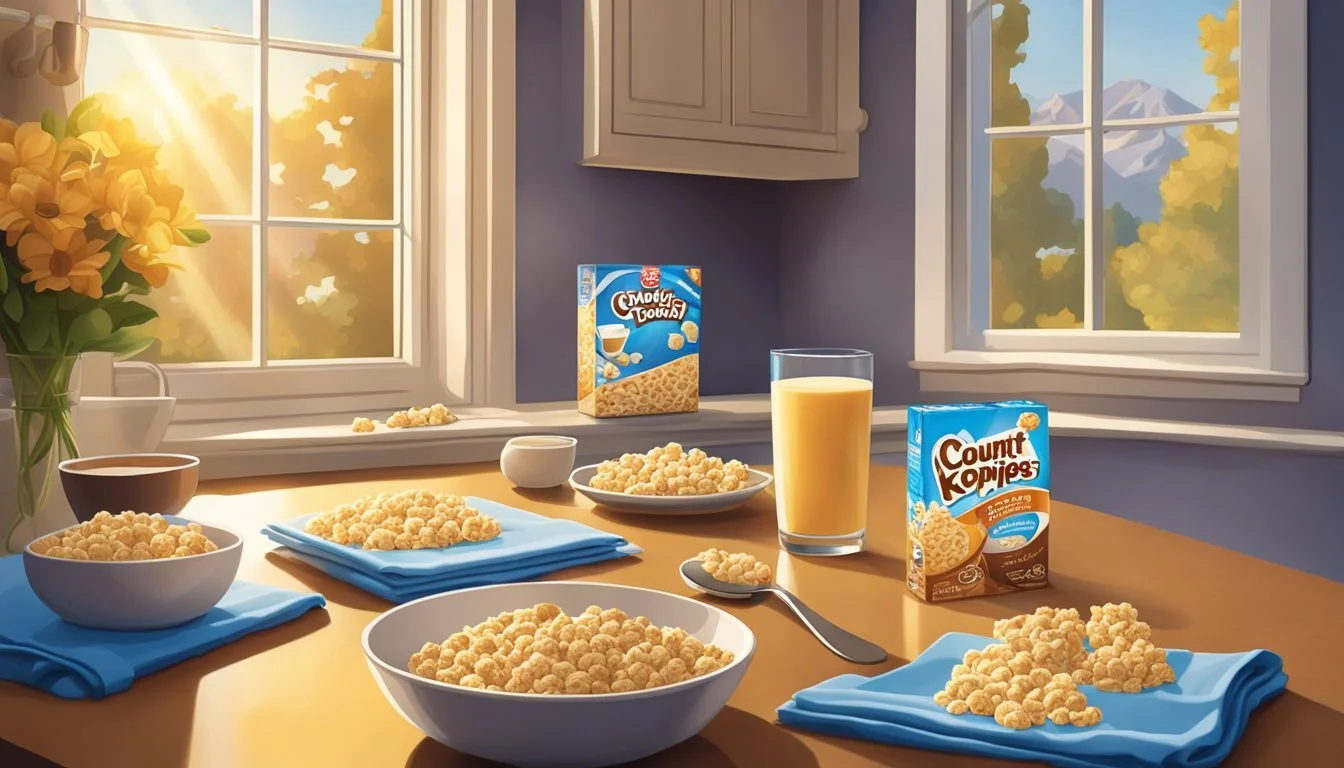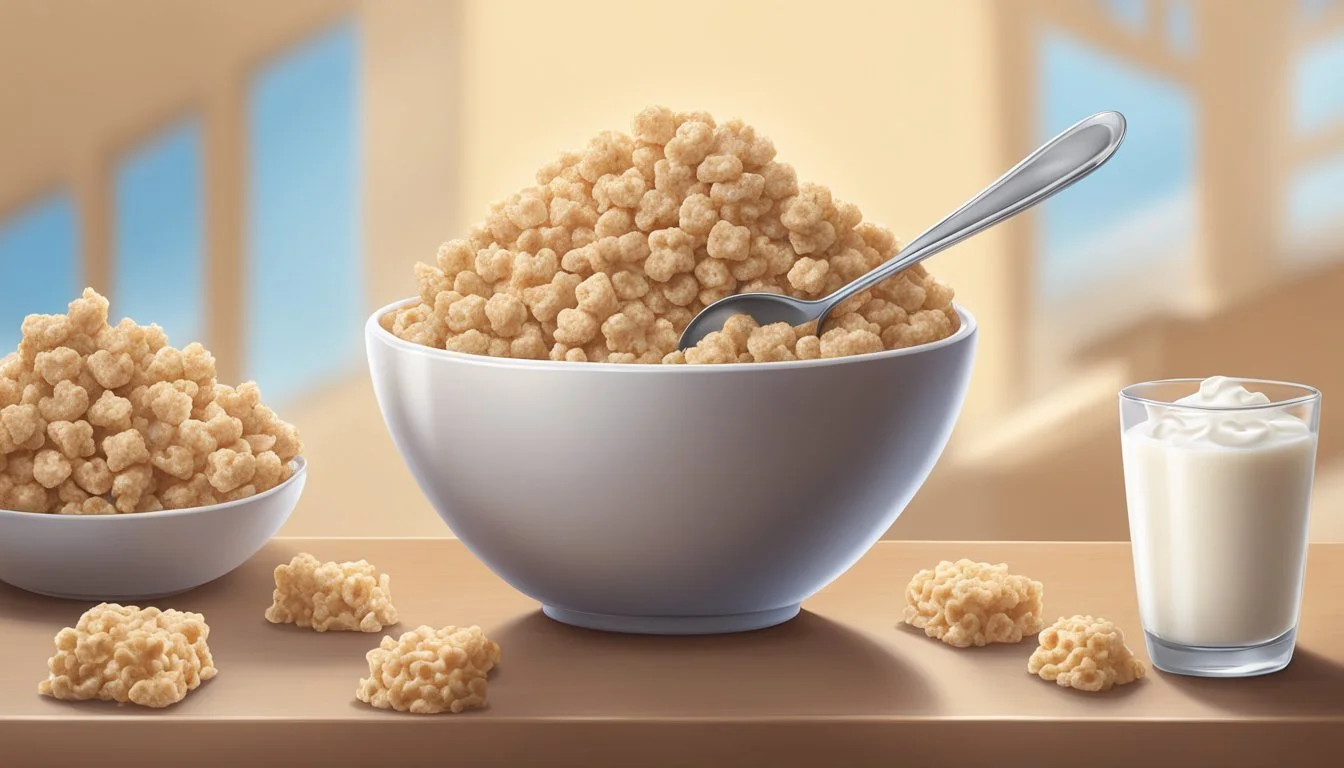Count Chocula vs Rice Krispies
Comparing Breakfast Cereal Choices
This Article is Part of Our Breakfast Cereal Guide with Details on Count Chocula Nutrition and Rice Krispies Nutrition
When it comes to choosing a breakfast cereal in 2024, two popular options stand out: Count Chocula and Rice Krispies. For health-conscious individuals, the choice between these cereals can hinge on their nutritional benefits. Count Chocula surpasses Rice Krispies in several important nutrients, including Iron, Zinc, Calcium, and various B vitamins. This makes it a nutrient-dense option for those looking to boost their intake of these essential vitamins and minerals.
While both cereals have their fans, Count Chocula's higher content of Iron and Calcium may make it a more appealing choice for those needing to boost their mineral intake. With 37 times more Calcium than Rice Krispies, Count Chocula can significantly contribute to daily calcium needs. Additionally, its higher Iron content can benefit many, especially those with increased Iron requirements.
Despite the nutritional edge that Count Chocula holds, some may prefer Rice Krispies for its simplicity and lower sugar content. Each cereal offers distinct benefits, capturing different aspects of what consumers look for in their breakfast choices. Whether for nutritional fortification or a more traditional breakfast experience, the decision ultimately depends on individual dietary needs and preferences.
Historical Background of Breakfast Cereals
Breakfast cereals have evolved significantly since their inception in the late 19th century. Initially created as health foods, they quickly became staples in American households.
The Kellogg's brothers were pioneers in this domain. They introduced Corn Flakes in 1894, aiming to provide a nutritious breakfast option. This move marked the beginning of the cereal revolution.
Rice Krispies, another popular product from Kellogg's, debuted in 1928. Known for its distinctive snap, crackle, and pop, it quickly gained popularity.
Post began its journey in the cereal market with Grape-Nuts in 1897. The company later introduced other favorites such as Honeycomb and Fruity Pebbles.
General Mills entered the scene with Cheerios in 1941. With the launch of Count Chocula in 1971, they tapped into the fun, themed cereal market, especially popular around Halloween.
By the 1920s, ready-to-eat cereals became a breakfast staple, driven by convenience and effective marketing campaigns.
The post-World War II baby boom further increased cereal consumption. New products like Frosted Flakes and their mascot, Tony the Tiger, emerged.
The 1970s are often referred to as the Golden Age of Breakfast Cereals. Iconic products like Fruity Pebbles, Cocoa Pebbles, and Golden Grahams became household names.
Count Chocula, with its chocolate flavor and cartoonish vampire mascot, joined this lineup and became particularly popular with children.
Breakfast cereals remain a significant part of the morning routine, with companies like Kellogg's and General Mills constantly innovating.
Comparative Nutritional Analysis
Count Chocula and Rice Krispies differ significantly in their nutritional content, offering various micronutrients and macronutrients that cater to different dietary needs. This comparison breaks down essential aspects like calorie content, sugar, fiber, vitamins, minerals, and fat types in detail.
Caloric Content and Macronutrient Comparison
Both Count Chocula and Rice Krispies contain 110 calories per serving, ensuring no caloric difference when choosing between the two.
Protein content varies; Rice Krispies provide 2 grams of protein per serving, while Count Chocula offers only 1 gram. Fat content also differs, with Count Chocula having 1 gram and Rice Krispies containing 0 grams.
Sodium levels show a notable difference: Count Chocula has 180 milligrams, whereas Rice Krispies possess a higher 290 milligrams per serving. Consumers seeking lower sodium might prefer Count Chocula.
Sugar and Fiber Content
Count Chocula contains a higher degree of sugar compared to Rice Krispies, which is significant for those monitoring their sugar intake.
However, both cereals lack dietary fiber, presenting 0 grams of fiber in Count Chocula and minimal fiber content in Rice Krispies.
This lack of fiber could be a concern for those prioritizing digestive health and balanced blood sugar levels.
Vitamin and Mineral Profile
Count Chocula excels in delivering numerous vitamins and minerals. For instance, it provides 370 milligrams of calcium, far surpassing Rice Krispies' 10 milligrams.
Iron content is also notable, with Count Chocula covering 134% more iron than Rice Krispies. Moreover, Count Chocula has higher levels of zinc, vitamin B12, vitamin B6, vitamin B2, vitamin B1, and vitamin B3.
Rice Krispies, however, do not match these figures, making Count Chocula more nutrient-dense when considering micronutrients.
Saturation and Type of Fats
Examining fat types, both Count Chocula and Rice Krispies maintain a low-fat profile. Count Chocula's 1 gram of fat includes minimal saturated fat.
Rice Krispies contain no fat and therefore no saturated fat, enhancing its appeal for those avoiding any fat intake.
Neither cereal contains cholesterol, maintaining their stance as low-fat breakfast options fitting various dietary preferences.
Health Impact and Dietary Considerations
Count Chocula and Rice Krispies differ significantly in terms of their nutritional profiles, affecting decisions related to health impacts. Key areas of focus include their effects on blood sugar regulation, the presence of additives and preservatives, and concerns related to allergens and dietary restrictions.
Glycemic Index and Blood Sugar Regulation
Count Chocula generally contains more sugar compared to Rice Krispies. Rice Krispies have a lower sugar content, which impacts their glycemic index. The glycemic index (GI) measures how quickly foods raise blood sugar levels. High GI foods cause rapid spikes, while low GI foods result in steadier increases.
Additives and Preservatives
Count Chocula includes various additives and preservatives like BHT (Butylated Hydroxytoluene), which helps maintain shelf-life and freshness. Rice Krispies, although simpler, sometimes contain additives like TBHQ for preservation.
Cereal Additives and Preservatives Count Chocula BHT, artificial coloring, flavoring Rice Krispies TBHQ, artificial flavoring
BHT and TBHQ are used to prevent oxidative rancidity, but their health impacts are debated.
Allergens and Dietary Restrictions
Count Chocula contains ingredients such as milk and soy, posing potential issues for those with allergies. Rice Krispies might also contain soy and dairy. Vegans often avoid Rice Krispies due to vitamin D3 derived from animal sources.
Dietary fiber is minimal in both, but non-existent in Rice Krispies, making Count Chocula slightly more beneficial for digestive health. Sodium levels should be monitored, as high sodium intake contributes to hypertension and heart disease.
Sugar content and potential allergens must be considered when evaluating each cereal's suitability for specific dietary needs.
Consumer Preferences and Popularity
Count Chocula and Rice Krispies cater to different taste preferences and purchasing influences, making them favorites for different kinds of cereal consumers. This section covers flavor profiles, marketing tactics, and the impact of seasonal offerings on consumer choices.
Flavor Profiles and Varieties
Count Chocula features a chocolate flavor with a moderate level of sweetness, making it a go-to choice for those who enjoy sweet, chocolatey cereals. The cereal often includes marshmallows, adding a unique texture and additional sweetness.
Rice Krispies, known for their light flavor and subtle sweetness, appeal to those who prefer a more neutral taste. They are also versatile, commonly used in homemade treats like Rice Krispie squares.
While Count Chocula is a specific product, Rice Krispies belong to a broader product line, including Cocoa Krispies, which offer a chocolate variant of the classic.
Marketing Influence on Purchase Decisions
Count Chocula leverages nostalgia and a strong brand character to attract consumers, especially around Halloween. General Mills often markets it alongside other seasonal cereals like Franken Berry and Boo Berry.
Rice Krispies, produced by Kellogg's, relies on its versatility and classic status in the cereal market. The famous slogan "Snap! Crackle! Pop!" and its three iconic mascots are well-recognized and heavily featured in advertising.
Seasonal campaigns and limited-edition flavors play a significant role in driving Count Chocula sales, while Rice Krispies benefit from consistent branding and promotional efforts highlighting its use in recipes.
Seasonal and Limited-Edition Offerings
Count Chocula is predominantly marketed during the Halloween season, creating a sense of scarcity and driving up demand. This seasonal availability makes it a special treat that consumers look forward to annually.
Rice Krispies do not typically have seasonal variations but often feature special packaging and partnerships during holidays. These promotions usually encourage creative use of the cereal in festive recipes.
The limited-edition nature of Count Chocula provides a unique market strategy, while Rice Krispies maintains consistent appeal through its year-round availability and multi-purpose use.
Cereal as an Ingredient and Culinary Uses
Cereals like Count Chocula and Rice Krispies are not just for breakfast; they offer a range of culinary applications. These cereals can be utilized in homemade desserts and snacks as well as in professional culinary settings for innovative dishes.
Homemade Desserts and Snacks
Count Chocula and Rice Krispies are popular ingredients for a variety of homemade desserts and snacks. Rice Krispie treats are a classic example, combining Rice Krispies with melted marshmallows and butter for a simple and delicious treat.
Count Chocula, with its chocolatey flavor, adds a unique twist to traditional recipes. It can be used in chocolate-based granola bars or as a topping for ice cream, lending both texture and a rich taste.
Both cereals can also be used to create fun and festive desserts. For example, incorporating Rice Krispies into cakes or cookies adds a crunchy element. Count Chocula can be mixed with melted chocolate and shaped into various holiday-themed treats.
Professional Culinary Applications
In professional kitchens, Count Chocula and Rice Krispies are used creatively to enhance desserts and other dishes. Pastry chefs often use Rice Krispies to add texture to gourmet desserts. They might coat a mousse or pudding with a Rice Krispie crust for a crunchy contrast.
Count Chocula can be ground into a fine powder and used as a flavor enhancer. This is particularly effective in items like chocolate truffles, where the cereal powder adds complexity and depth.
Additionally, cereals like these are sometimes used in savory applications. Rice Krispies, for example, can serve as a crunchy topping for fried chicken or be integrated into stuffing mixtures for a unique texture.
Brand Varieties and Product Line Extensions
General Mills and Kellogg's, known for their wide-ranging portfolios, offer a variety of cereals that cater to different tastes and nutritional preferences. These companies leverage brand extension strategies to introduce new products under familiar brands, often enhancing consumer loyalty and expanding market reach.
General Mills and Kellogg's Portfolio
General Mills boasts an extensive lineup with popular cereals such as Count Chocula, Cocoa Puffs, Lucky Charms, and Cinnamon Toast Crunch. Each cereal caters to specific tastes, from the chocolatey goodness of Count Chocula to the sugary crunch of Cinnamon Toast Crunch.
They also introduce limited-edition versions like Boo Berry and Franken Berry during holiday seasons, keeping the brand fresh and engaging.
Kellogg's offers iconic products like Rice Krispies, Corn Flakes, Froot Loops, and Apple Jacks. Rice Krispies stands out with its distinctive snap, crackle, and pop, while Froot Loops offers a burst of fruity flavors.
Kellogg's frequently explores product line extensions, such as Rice Krispies Treats, a popular snack variant that builds on the original cereal's reputation.
Comparing Similar Cereals
When comparing cereals from these brands, like Count Chocula and Rice Krispies, it's crucial to look at nutritional content, flavor profiles, and consumer preferences. Count Chocula offers a chocolate-flavored experience with added marshmallows, appealing to those with a sweet tooth.
On the other hand, Rice Krispies provides a lighter, crispier texture and is often chosen for its versatility in recipes like homemade snacks.
Additionally, General Mills' Cocoa Puffs can be compared to Count Chocula for their overlapping chocolate flavor, though Cocoa Puffs lacks the marshmallows. Meanwhile, Kellogg's Corn Flakes and Rice Krispies are both staples that offer simplicity and breakfast versatility.
By exploring the range of cereals and their extensions, consumers can make informed choices that best suit their flavor preferences and dietary needs.







